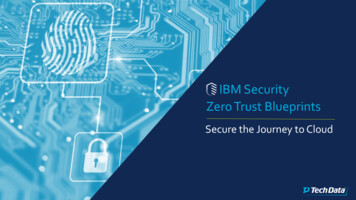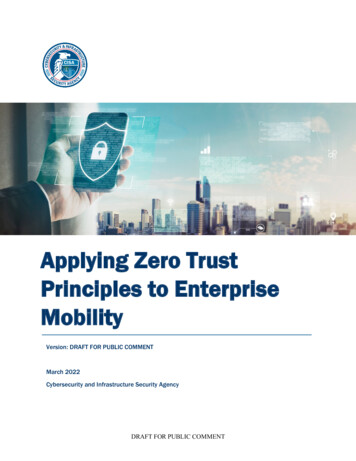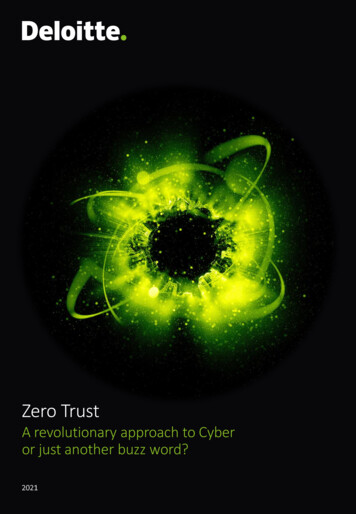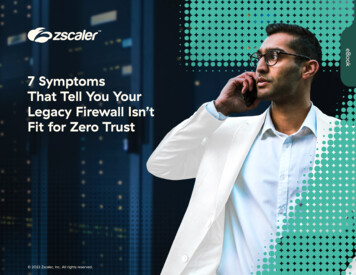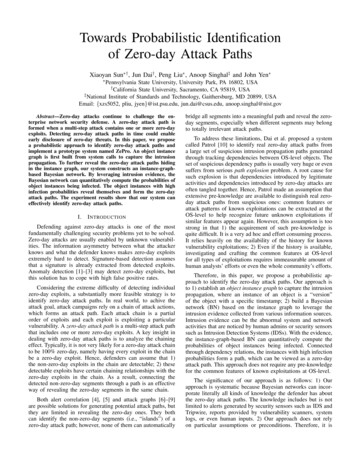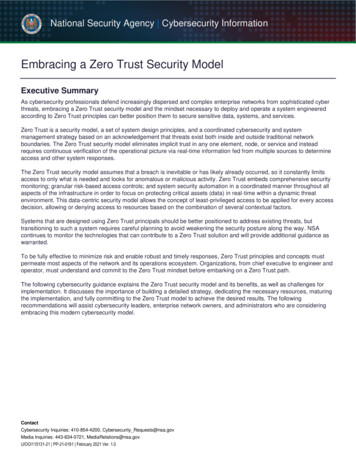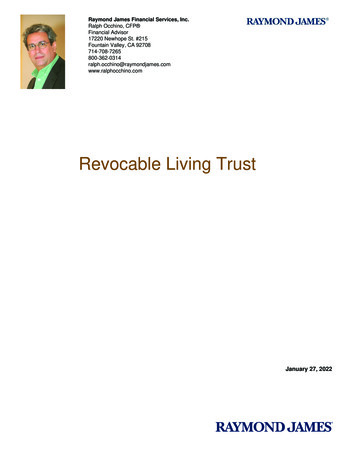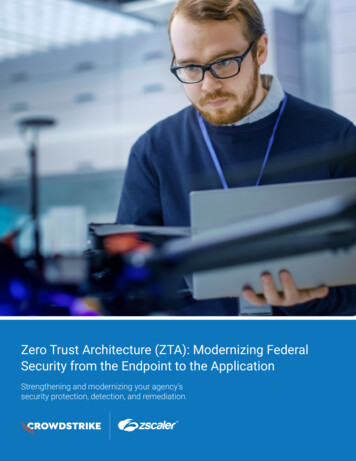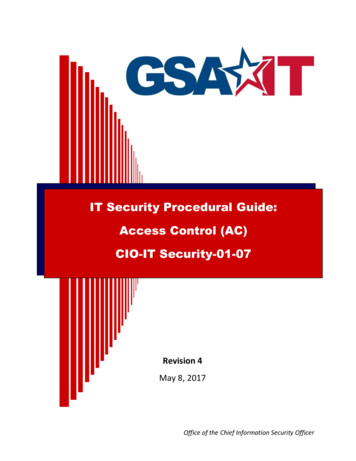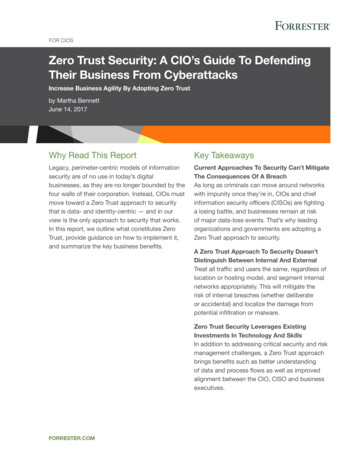
Transcription
For CIOsZero Trust Security: A CIO’s Guide To DefendingTheir Business From CyberattacksIncrease Business Agility By Adopting Zero Trustby Martha BennettJune 14, 2017Why Read This ReportKey TakeawaysLegacy, perimeter-centric models of informationsecurity are of no use in today’s digitalbusinesses, as they are no longer bounded by thefour walls of their corporation. Instead, CIOs mustmove toward a Zero Trust approach to securitythat is data- and identity-centric — and in ourview is the only approach to security that works.In this report, we outline what constitutes ZeroTrust, provide guidance on how to implement it,and summarize the key business benefits.Current Approaches To Security Can’t MitigateThe Consequences Of A BreachAs long as criminals can move around networkswith impunity once they’re in, CIOs and chiefinformation security officers (CISOs) are fightinga losing battle, and businesses remain at riskof major data-loss events. That’s why leadingorganizations and governments are adopting aZero Trust approach to security.A Zero Trust Approach To Security Doesn’tDistinguish Between Internal And ExternalTreat all traffic and users the same, regardless oflocation or hosting model, and segment internalnetworks appropriately. This will mitigate therisk of internal breaches (whether deliberateor accidental) and localize the damage frompotential infiltration or malware.Zero Trust Security Leverages ExistingInvestments In Technology And SkillsIn addition to addressing critical security and riskmanagement challenges, a Zero Trust approachbrings benefits such as better understandingof data and process flows as well as improvedalignment between the CIO, CISO and businessexecutives.forrester.com
For CIOsZero Trust Security: A CIO’s Guide To Defending Their BusinessFrom CyberattacksIncrease Business Agility By Adopting Zero Trustby Martha Bennettwith Stephanie Balaouras and Michael GlennJune 14, 2017Table Of Contents2 Adopting A Zero Trust Approach To SecurityIs ImperativeTake “Zero Trust” Literally, And StopDifferentiating Between Internal And ExternalFollow These Five Steps To Zero TrustInformation SecurityRelated Research DocumentsCalculate The Business Impact And Cost Of ABreachCreating Actionable Security And Privacy PolicyThe Future Of Data Security And Privacy: GrowthAnd Competitive Differentiation6 Zero Trust Security Delivers Many BusinessBenefitsRecommendations8 Use Zero Trust As An Opportunity ToTransform Your Business10 Supplemental MaterialForrester Research, Inc., 60 Acorn Park Drive, Cambridge, MA 02140 USA 1 617-613-6000 Fax: 1 617-613-5000 forrester.com 2017 Forrester Research, Inc. Opinions reflect judgment at the time and are subject to change. Forrester ,Technographics , Forrester Wave, TechRadar, and Total Economic Impact are trademarks of Forrester Research,Inc. All other trademarks are the property of their respective companies. Unauthorized copying or distributingis a violation of copyright law. Citations@forrester.com or 1 866-367-7378
For CIOsJune 14, 2017Zero Trust Security: A CIO’s Guide To Defending Their Business From CyberattacksIncrease Business Agility By Adopting Zero TrustAdopting A Zero Trust Approach To Security Is ImperativeAsk CIOs what keeps them awake at night, and security is bound to be on the list, if not at the top.While security has always been a concern, CEOs now care about security to a degree they mostlydidn’t in the past. A key catalyst for this sentiment change was the Target hack in 2013, which was thefirst documented and well-publicized occurrence of a CEO and CIO losing their jobs as the result of asecurity breach.1 Since then, a parade of mega breaches and nation-state cyberattacks on governmentand enterprise systems has underlined the fact that existing approaches to security aren’t the answer.2The Zero Trust approach to security is the only strategic model that can create a win-win situation for thebusiness as well as the CIO — and it’s a model that security teams and their counterparts can begin toimplement today. Any CIO who remains ambivalent about moving to Zero Trust should bear in mind that:›› Current approaches to security can’t mitigate the consequences of a breach. While the Targetbreach and its aftermath marked a major milestone in attitudes, security in most organizations stillhasn’t evolved from conventional approaches that clearly don’t work. Another CEO made headlinesin late 2015 when UK telecom firm TalkTalk suffered a major breach, and she admitted publicly thatnobody quite knew what security measures were actually in place, despite the widely held view thatthe company was taking security very seriously.3 In the weeks following TalkTalk’s customer breach,the company’s shares plummeted by 20%.4 A few months later, the company reported the loss of100,000 customers and costs of about 60 million.5›› Major government organizations are moving toward Zero Trust. On September 7, 2016, TheUS House Committee on Oversight and Government Reform (OGR) issued a scathing rebuke ofthe US Office of Personnel Management’s (OPM’s) security practices, which led to one of the mostsignificant data breaches in history.6 In the OGR report, the committee suggested that governmentagencies “reprioritize federal information security efforts toward a zero trust model.” It also askedthe US Office of Management and Budget to “provide guidance to agencies to promote a zerotrust IT security model.” In the US, as more federal CIOs and CISOs adopting Zero Trust, weexpect this adoption to ripple to the industries that do business with and sell technology to theUS government. As nation-state attacks and concerns increase, we expect other governments toadopt Zero Trust.Take “Zero Trust” Literally, And Stop Differentiating Between Internal And ExternalZero Trust is an architectural model for how security teams should redesign networks into securemicroperimeters, increase data security through obfuscation techniques, limit the risks associatedwith excessive user privileges, and dramatically improve security detection and response throughanalytics and automation. Zero Trust demands that CIOs and CISOs move away from legacy,perimeter-centric models of information security — which are useless for today’s digital businesses,no longer bounded by the four walls of their corporation — to a model that is both data- and identitycentric and extends security across the entire business ecosystem. We call our model Zero Trustbecause we want to warn security leaders about the dangers of the numerous trust assumptions 2017 Forrester Research, Inc. Unauthorized copying or distributing is a violation of copyright law.Citations@forrester.com or 1 866-367-73782
For CIOsJune 14, 2017Zero Trust Security: A CIO’s Guide To Defending Their Business From CyberattacksIncrease Business Agility By Adopting Zero Trustthey make in their architecture — whether that’s trusting that internal network traffic is legitimate bydefault, trusting your employees to always have the best intentions or to never make bad decisions,trusting partners to treat access to your systems and your data like it was their own, and so on (seeFigure 1). Three concepts are at the heart of Zero Trust:7›› Ensure all resources are accessed securely, regardless of location or hosting model. Thismeans working on the assumption that all traffic is threat traffic until you’ve authorized, inspected,and secured it, regardless of whether an internal or external party is accessing your systems andregardless of whether the data is located within your data center or in the cloud. It also meansadopting a data- and identity-centric approach. Integral to this is the concept of microperimeters,which support more granular access restrictions and additional security controls. If you segmentyour sensitive systems and data into a series of microperimeters, rather than simply design onemonolithic network akin to a castle wall, then a breach of the network doesn’t give cybercriminalsor malicious insiders free reign across the entire environment.›› Adopt a “least privilege” strategy and strictly enforce access control. Providing peoplewith only the right amount of access they require to do their job not only mitigates against therisk of malicious access, it also reduces the risk of employees leaking data. While Zero Trustdoesn’t specify role-based access as the preferred access control methodology, it’s the mostcommonly used today. To go with it, you’ll also need an identity and access governance strategyto periodically review and recertify access rights.8 For employees with access to the most sensitivesystems, implement privileged identity management solutions; these provide additional controlmechanisms, such as the requirement to check out passwords.9›› Inspect and log all traffic for suspicious activity. Even the strictest access controls only go sofar. That’s why it’s important to change the “trust but verify” paradigm to the more appropriate“verify and never trust.” Security teams could have detected and contained some of the largestbreaches in the recent past if they had been monitoring for anomalous user behavior or networkactivity. For example, in January 2014, financial regulators revealed that a contractor at the KoreaCredit Bureau stole more than 105 million records containing the personal information of 20 millionSouth Koreans — nearly 40% of the population. When a privileged user downloads 105 millionrecords containing sensitive information from a production database to removable media, securityanalysts in the security operations center should notice. They should automatically block thetransfer of this data, reset user passwords and privileges, and begin an investigation.10 2017 Forrester Research, Inc. Unauthorized copying or distributing is a violation of copyright law.Citations@forrester.com or 1 866-367-73783
For CIOsJune 14, 2017Zero Trust Security: A CIO’s Guide To Defending Their Business From CyberattacksIncrease Business Agility By Adopting Zero TrustFIGURE 1 The Most Common Security Breaches Remain Internal Events“What were the most common ways in which the breach(es) occurred in the past12 months?”2015201639%Internal incident within our organization43%28%External attack targeting a businesspartner/third-party supplier34%30%External attack targeting our organization30%19%Internal incident within a business partner’s/third-party supplier’s organization22%23%Lost/stolen assetDon’t know20%9%5%Base: 565 (2015) and 619 (2016) global network security decision makers whose firms had a securitybreach in the past 12 monthsNote: Multiple responses are accepted; “Other” responses are excluded.Source: Forrester Data Global Business Technographics Security Survey, 2015 and 2016Follow These Five Steps To Zero Trust Information SecurityA Zero Trust architecture is an essential element in your overall security strategy, but it isn’t theonly element. You still need, for example, to scope the responsibilities of your security function, itsorganizational structure and staffing, as well as a road map for capital and operating expenditure.Moving toward Zero Trust clearly has implications for the other components of your security strategy,which are beyond the scope of this report. Focusing on Zero Trust, Forrester recommends yourorganization’s security team take the following steps:111. Identify and classify sensitive data, and segment your network accordingly. When classifyingyour data, keep it simple. Three overarching categories will suffice: public (loss doesn’t harmeither employees or customers), toxic (loss is undesirable but harm is minimal), and radioactive 2017 Forrester Research, Inc. Unauthorized copying or distributing is a violation of copyright law.Citations@forrester.com or 1 866-367-73784
For CIOsJune 14, 2017Zero Trust Security: A CIO’s Guide To Defending Their Business From CyberattacksIncrease Business Agility By Adopting Zero Trust(loss results in privacy or other compliance violations; intellectual property is compromised).Categorizing data in this way makes it more likely that your classification project works. In terms ofnetwork design, the goal is to create small network segments, or microperimeters, which you canthen combine to create a larger Zero Trust network (see Figure 2).2. Map the flow of your sensitive data. Before you design a Zero Trust network, you mustunderstand how your data flows across your network as well as between users and applications(including associated resources such as storage). You’ll need to engage multiple stakeholders atthis stage and establish a cross-functional team; these typically include application architects,network architects, enterprise architects, and business domain experts. The team will need tolocate and map all dependent network and computer objects; while this sounds onerous, it’sa critical step that has other benefits, such as providing you with the opportunity to optimizeflows, retire redundant hardware or software, and so on. You can leverage data flow and networkdiagrams from compliance initiatives such as PCI.3. Architect your Zero Trust security network. The design of your Zero Trust network will reflecthow transactions flow across it and how users and other systems access sensitive data. Createmicroperimeters around sensitive data. You can enforce these segments with physical or virtualappliances, such as next-generation firewalls from vendors like Check Point Software, CiscoSystems, Fortinent, and Palo Alto Networks, but there are alternative approaches that useobfuscation techniques for network segmentation, such as Unisys’ Stealth offering.4. Create fine-grained security policies to enforce access controls and segmentation. Toenforce strictly limited access, security pros must put in place fine-grained authorizations.Too often, security teams rely on inaccurate, manual, and inefficient identity processes. CIOsand CISOs should adopt an identity management and governance platform (e.g., SailPoint orRSA) that provides user account provisioning, role management, access request management,and access certification. Security leaders should also ensure that security teams configure,continuously audit, and optimize the rule sets in network access controls, next-generationfirewalls, and other network-basedsolutions that can analyze, control,and block network traffic. Today, theseWhen classifying yoursolutions have app layer visibility thatdata, keep it simple. Threeenables security teams to allow, deny, oroverarching categories willrestrict access to specific applications.suffice.5. Continuously monitor your ZeroTrust ecosystem. As discussed, a keycharacteristic of a Zero Trust network is thelogging and inspecting of all traffic, regardless of whether it’s internal or external. When preventivecontrols fail, security teams must rely on network and application visibility to quickly identify andrespond to security incidents. Today’s security analytics solutions ingest and correlate data from 2017 Forrester Research, Inc. Unauthorized copying or distributing is a violation of copyright law.Citations@forrester.com or 1 866-367-73785
For CIOsJune 14, 2017Zero Trust Security: A CIO’s Guide To Defending Their Business From CyberattacksIncrease Business Agility By Adopting Zero Trustmultiple disparate sources, including network flow data, identity data, user behavior data, andapp-specific data. Features like security user behavior analytics provide insight into user activityto identify malicious users and compromised accounts. Carefully examine your network traffic toidentify signs of malicious behavior like compromised accounts or infected endpoints.12FIGURE 2 Create A Zero Trust Model With Three Classifications Of DataData users use this tagging and provide feedback on tags.Datacreatordeterminestoxicity.Data owner tags and audits; data auditor reviews.3P IP TD Data is subject to local/national laws. Data is subject to compliance regulations. Data loss will violate a business agreement.Data is considered intellectualproperty. What is the value ofthis data to a competitor?Data iscreated.Is it toxic?YesNoData loss willWill the impactharm employeesviolate privacyand/or customers. or result indirect costs?ValuableNot veryuseful (rare)YesRadioactiveNoData loss won’tharm employeesor customers.ToxicPublicZero Trust Security Delivers Many Business BenefitsProtecting the business from harm is the core of all security measures and initiatives. A Zero Trustapproach to security clearly has the same aim, but the benefits for the business go much further. Wehave identified eight key business and security benefits.13 Zero Trust:›› Improves visibility throughout the network and reduces time to breach detection. Commonrefrains in reports about serious breaches include “the hackers were able to work undetected for Xnumber of months” and “once the bad guys were in, they were able to move around the networkunhindered.” With Zero Trust, security pros have visibility into exactly what’s going on at all times,and they are able to stop an attack as soon as the tell-tale signs become apparent. In 2016, Yahoorevealed that cybercriminals had compromised the personally identifiable information (PII) for up to 2017 Forrester Research, Inc. Unauthorized copying or distributing is a violation of copyright law.Citations@forrester.com or 1 866-367-73786
For CIOsJune 14, 2017Zero Trust Security: A CIO’s Guide To Defending Their Business From CyberattacksIncrease Business Agility By Adopting Zero Trust1 billion user accounts. The initial breach occurred in late 2014, but Yahoo did not discover it untilAugust 2016, in the course of a separate breach investigation. As a result, Verizon slashed its offerprice for Yahoo by 350 million. Additional breach costs, particularly from lawsuits, are inevitable.14›› Stops malware propagation and lateral movement. In traditional networks, malware typicallypenetrates much more deeply into systems than is apparent, due to lack of segmentation and poornetwork visibility. It’s different in a Zero Trust network: The combination of more granular network rulesand microperimeters around specific data types, assets, services, and applications makes it muchharder for malware to propagate or for an attacker to gain access to other systems. For example, ifyou’re a hospital, a breach of the POS system in the cafeteria or gift shop doesn’t allow attackersto gain access to clinical systems. If you’re a retailer, a malware infection in one corporate systemdoesn’t allow attackers to infect every one of your brick-and-mortar locations within two weeks.›› Reduces both capital and operational expenditures on security. Improving security is invariablyassociated with increased cost. With Zero Trust, this is typically not the case; to the contrary,improved security enables CIOs and security pros to reduce both one-off and ongoing outlays. Forexample, next-generation firewalls consolidate disparate security controls into a single solution with asingle management console. Combined with centralizing the location of security tools, the reductionin the number of disparate security solutions also means reduced training costs, and it enablessecurity pros to focus on key security activities rather than spend time managing the environment.›› Shrinks the scope and cost of compliance initiatives. Because Zero Trust networks are bydefinition segmented, a compliance initiative need only involve the relevant network segment. Bycomparison, without network segmentation, it’s likely that the entire network is in scope when itcomes to proving regulatory compliance (as is the case with PCI DSS, for example). Compliancewith the EU’s General Data Protection Regulation (GDPR) will also be much easier to achieve andprove under a Zero Trust approach. Compliance audits also become a lot less painful, as many ofthe things auditors will look for — and typically recommend for remediation — are inherently part ofa Zero Trust network design.›› Eliminates finger-pointing and fosters a more mature tech management approach. CIOstypically have a variety of organizational units reporting to them: network teams, operations teams,computing/virtualization teams, application development teams, security teams, and so on. Whensomething goes wrong, the buck-passing starts: It was the fault of the network team; no, it wasthe fault of the security team; no, the app dev folks are to blame; and so on. By contrast, ZeroTrust builds bridges by requiring collaboration between teams. The real-time root-cause analysis,transparency, and visibility inherent in Zero Trust further support the move from finger-pointing tocooperation. This breaking down of silos in turn provides a good basis for the entire technologymanagement organization to become more agile and develop a more mature approach.›› Increases data awareness and insight. Once you know what data you have, where it is, andhow you should classify it, security pros can set the right policies and make sure that the mostsensitive data is subject to the strongest controls. And just as Zero Trust gives you visibility into 2017 Forrester Research, Inc. Unauthorized copying or distributing is a violation of copyright law.Citations@forrester.com or 1 866-367-73787
For CIOsJune 14, 2017Zero Trust Security: A CIO’s Guide To Defending Their Business From CyberattacksIncrease Business Agility By Adopting Zero Trustpotential threat traffic, it also gives you greater insight into your data and how it moves across thenetwork. This enables you to identify potential compliance breaches before they become a problem(e.g., sharing data with a third party without approval or transferring personal data outside of thejurisdiction where it’s meant to reside).›› Protects your business as well as your customers. Allowing sensitive data to get into the wronghands can have serious and material business consequences, whether it’s large fines for not takingsufficient care of personal data or loss of revenue resulting from the theft of IP or strategic plans.The direct business benefits of stopping the exfiltration of data are obvious. But there’s anotherpositive effect: If your customers’ data can’t get stolen, they won’t have to deal with the aftermath,which can be traumatic and long-lasting for those whose personal details are subsequently used tocommit other crimes. Sparing your customers this inconvenience and distress can only be good foryour reputation as a company to do business with.›› Enables digital business transformation. Digital businesses have no boundaries, and they existwherever your customers, partners, and employees choose to connect and interact with yourservices. The disappearance of corporate perimeters increasingly applies to physical environments,too, as we outfit retail environments with Wi-Fi and beacons, equip elevators and air conditioningsystems with sensors and the ability to “phone home,” and connect machines on the factory floorin real time. While this ubiquitous connectivity increases the attack surface, Zero Trust enablesyou to manage the risk by, for example, creating microperimeters around internet-of-things (IoT)devices. A Zero Trust approach also makes it easier to connect or adjust services, which in turnincreases agility and allows you to realize transformational potential.RecommendationsUse Zero Trust As An Opportunity To Transform Your BusinessIt seems paradoxical, but by never assuming trust in our technology architecture and operations,we actually make the reliability, dependability, and security of our organization more trustworthyfor the customers that choose to engage with us, the citizens and patients that rely on us, and thepartners that do business with us. These trusted relationships will fuel the success and growth of yourorganization. For CIOs and the security teams that report to them, Zero Trust represents an opportunityto move away from the “department of no” label to become an enabler of business transformation. Toget the Zero Trust journey underway, CIOs should:›› Position Zero Trust as a foundational business initiative, not a security project. In additionto the business benefits arising from improved security and lower risk, Zero Trust puts in place anessential building block for any analytics initiative an organization might wish to embark upon: theunderstanding of what data you’ve got, where it resides, and who can handle it for what purpose. 2017 Forrester Research, Inc. Unauthorized copying or distributing is a violation of copyright law.Citations@forrester.com or 1 866-367-73788
For CIOsJune 14, 2017Zero Trust Security: A CIO’s Guide To Defending Their Business From CyberattacksIncrease Business Agility By Adopting Zero Trust›› Align with the chief information security officer around Zero Trust. CISOs and CIOs typicallyhave different objectives and incentives, which can lead to conflict and finger-pointing. Zero Trustallows CIOs and CISOs to work toward a common goal and give the CISO a stronger story to sharewith the board. However, CISOs shouldreport to the CEO, not the CIO; whetherperceived or real, a CIO reporting lineThere are no legitimateleads to a potential lack of transparency,business objections to Zerowhich in turn can increase business risk.Trust security.›› Refuse to take “no” for an answer. Thereare no legitimate business objections toZero Trust security. You’re not proposingto embark upon a potentially risky and costly rip-and-replace exercise; you’ll be using off-the-shelftools and existing skills. In other words, over time, you’ll break the seemingly endless upward spiralof security expenditure and instead lower costs — but with much improved security.Engage With An AnalystGain greater confidence in your decisions by working with Forrester thought leaders to applyour research to your specific business and technology initiatives.Analyst InquiryAnalyst AdvisoryWebinarTo help you put researchinto practice, connectwith an analyst to discussyour questions in a30-minute phone session— or opt for a responsevia email.Translate research intoaction by working withan analyst on a specificengagement in the formof custom strategysessions, workshops,or speeches.Join our online sessionson the latest researchaffecting your business.Each call includes analystQ&A and slides and isavailable on-demand.Learn more.Learn more.Learn more.Forrester’s research apps for iPhone and iPad Stay ahead of your competition no matter where you are. 2017 Forrester Research, Inc. Unauthorized copying or distributing is a violation of copyright law.Citations@forrester.com or 1 866-367-73789
For CIOsJune 14, 2017Zero Trust Security: A CIO’s Guide To Defending Their Business From CyberattacksIncrease Business Agility By Adopting Zero TrustSupplemental MaterialSurvey MethodologyThe Forrester Data Global Business Technographics Security Survey, 2016 was fielded in theMarch to May 2016. This online survey included 3,588 respondents in Australia, Brazil, Canada,China, France, Germany, India, New Zealand, the UK, and the US from companies with two or moreemployees. Research Now fielded this survey on behalf of Forrester. Survey respondent incentivesinclude points redeemable for gift certificates.Forrester’s Business Technographics ensures that the final survey population contains only those withsignificant involvement in the planning, funding, and purchasing of business and technology productsand services.The Forrester Data Global Business Technographics Security Survey, 2015 was fielded in Aprilthrough June of 2015 of 3,543 business and technology decision makers located in Australia, Brazil,Canada, China, France, Germany, India, New Zealand, the UK, and the US from companies with twoor more employees.Forrester’s Business Technographics provides demand-side insight into the priorities, investments, andcustomer journeys of business and technology decision makers and the workforce across the globe.Forrester collects data insights from qualified respondents in 10 countries spanning the Americas,Europe, and Asia. Business Technographics uses only superior data sources and advanced datacleaning techniques to ensure the highest data quality.Please note that the brand questions included in this survey should not be used to measure marketshare. The purpose of Forrester’s Business Technographics brand questions is to show usage of abrand by a specific target audience at one point in time.EndnotesSource: “Target tech chief resigns as it overhauls security,” CNBC, March 5, 2014 reach.html) and Clint Boulton, “Target BreachFallout Shows CEOs, CIOs Share Cybersecurity Stakes,” The Wall Street Journal, May 5, 2014 es/).12Examples of corporate data loss include: Evernote: 50 million records compromised in 2013; Living Social: 50 millionrecords compromised in 2013; eBay: 145 million records compromised in 2014; Home Depot: 56 million recordscompromised in 2014; Chase: 76 million records compromised in 2014. Yahoo: Several breaches between 2014 and2016, with over 1 billion user accounts compromised. Anthem: 80 million records compromised in 2015. One exampleof a nation-state attack is the OPM data breach in the US. Source: “The OPM Data Breach: How the GovernmentJeopardized Our National Security for More than a Generation,” United States House Committee on Oversight andGovernment Reform, September 7, 2016 ion.pdf). 2017 Forrester Research, Inc. Unauthorized copying or distributing is a violation of copyright law.Citations@forrester.com or 1 866-367-737810
For CIOsJune 14, 2017Zero Trust Security: A CIO’s Guide
is a violation of copyright law. Citations@forrester.com or 1 866-367-7378 Forrester research, Inc., 60 Acorn Park Drive, Cambridge, MA 02140 UsA 1 617-613-6000 Fax: 1 617-613-5000 forrester.com Table of Contents Adopting A Zero Trust Approach To Security Is Imperative Take "Zero Trust" Literally, And stop
